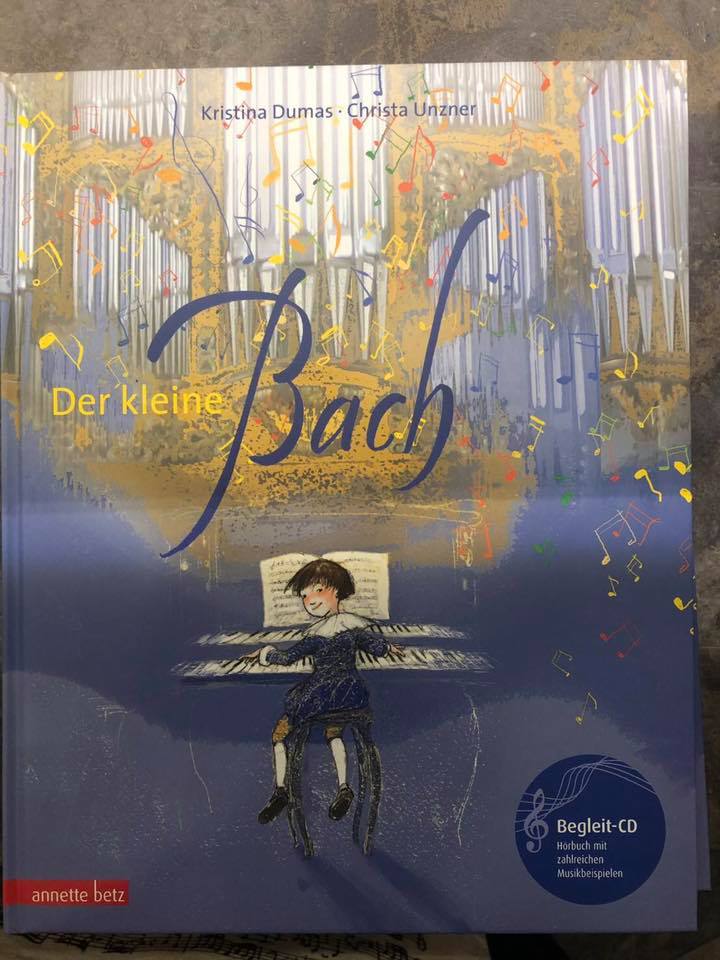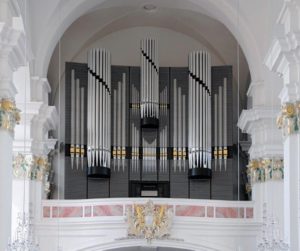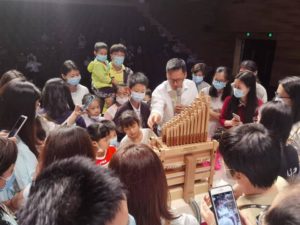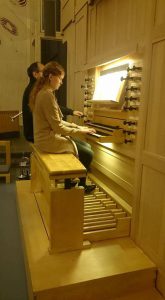新學期到來之際,我們特別邀請了Orgelkids China執行長蔣士挺(Justin Berg)博士帶來「兒童管風琴教育專欄」【初因初音】(My First Sound)。Justin要和大家分享他從小和管風琴奇妙的聯結,採用說故事的形式,讓兒童與管風琴相映成趣。讓我們跟隨Justin專欄,一起感受他從初音入耳,蛻變為一個管風琴家的成長之旅。Please stay tuned for more articles from the column “My First Sound” by Justin Berg, the Executive Director of Orgelkids China. (In English below)
【初因初音】(My First Sound)
我還記得第一次聽到管風琴聲響的經過。那座管風琴有一百多歲,前排的音管不但高大而且漆得閃閃發光。當時我年紀很小,還以為那些都是超大的的糖果棒,所以非常想看看內側還有怎樣的糖果。過了好幾年,我才獲邀走進這座樂器內部。
那裡的管風琴師願意帶我爸爸和我入內參觀,因此在某一天,我們真的站在琴座旁邊,注視著那些鍵盤和特殊拉紐,很好奇裡面藏著什麼秘密。管風琴師抵達後便打開一道側門,叫我們走進去。步入的那一刻,我立刻被好幾種濃濃的味道包圍,有老舊皮革的麝香味、發黴的異味、舊木料的怪味,還有金屬的味道。
那位管風琴師忽然點亮一盞燈,於是彷如森林的整堆古老音管出現在我們眼前,有各種長度、形狀、大小,但就是沒有糖果棒。其實這些音管上唯一的「塗料」就是一層厚厚的灰塵,我實在不懂:管風琴門面上的前排音管那麼美,裡面怎麼會那麼髒?我期待已久的那些糖果棒呢?我猜那位管風琴師看出了我的失望,因為她建議我們來玩個小遊戲。
「請你告訴我,你看到管風琴裡面有幾種音管?」
這一題很不好回答,因為音管有長有短、有胖有瘦,有些是圓管、有些是方管,還有木製與金屬製的分別,甚至有些有頂蓋、有些則沒有。有些音管旁邊好像黏著小片金屬或布料,也有些音管靠近頂端處有長方形的孔洞。
所以我回答說:「有太多種了,我沒辦法數完。」
管風琴師點點頭,對我說:「好,有一個辦法或許比較簡單,就是聽聽看各種不同的聲音,不必用數的。你要不要試著彈彈看?」
「我來彈嗎?」我驚訝地輕聲問她。「但我不會彈啊。」
她沒有回答,只是把一個音栓拉出來,用手示意要我彈最上排鍵盤。我伸手碰了一個琴鍵,立刻發出一個溫柔的聲音傳進房間裡,太神奇了。
「這些音管那麼骯髒,怎麼能發出這麼美妙的聲音呢?」我問她。
「管風琴幾乎可以彈奏出你所想要的任何聲音,」她回答,之後就坐下來彈奏,發出一個接一個聲音,從最寧靜的長笛,到最宏亮的小號。
過了非常多年,當我努力學習成為管風琴建造家的時候,我才終於明白這種雄偉華麗的樂器是如何發出美妙的樂音,但這就是另一篇故事的內容了。歡迎你下次再來,我會告訴你管風琴的肺部與聲音的秘密喔!
你的朋友蔣士挺
My First Sound
I remember the first organ I ever heard. It was more than 100 years old, with a front row of tall, brightly painted pipes. As a child, I thought they were giant sticks of candy, and I desperately wanted to see what other sweets were inside. But it was several years before I was invited to climb inside this instrument.
The organist there agreed to take my father and me on a tour, and so one day we found ourselves standing by the console, staring at all the keyboards and special drawknobs, wondering what secrets were hidden inside. The organist arrived, unlocked a side door, and asked us to step inside. As I entered the case, a strange mixture of strong smells surrounded me. There was the musk of old leather and the odor of mold, a curious fragrance of old wood and the smell of metal.
Suddenly, the organist flicked on a light, revealing a forest of ancient pipes. There were pipes of all lengths, shapes and sizes, but no sticks of candy. In fact, the only ‘paint’ on those pipes was a thick layer of dust. I felt confused: the organ’s facade — those front pipes — were so beautiful, I wondered how the inside could be so dirty. Where was all the candy I had hoped to find? I guess the organist could feel my disappointment, because she suggested we play a game.
“Can you tell me, how many different kinds of pipes do you see inside the organ?”
This was a hard question to answer. There were long pipes and short pipes, chubby pipes and skinny, round ones and square ones, some made of wood, others of metal, some with caps and others without. Some of the pipes seemed to have small pieces of metal or fabric glued to their sides, while others had holes near the top like long rectangles.
So I answered, “There are too many kinds, I can’t count them all.”
The organist nodded and said, “Alright, I have an idea. Maybe it’s easier to hear the different kinds, rather than count them. Do you want to try playing them?”
“Me??”, I whispered in astonishment, “But I don’t know how.”
She didn’t answer, but instead pulled out one of the stops and pointed for me to play on the highest keyboard. I reached out and touched one key, releasing a single, gentle note of music into the room. It was magic.
“The pipes are so dirty, how can they sing so sweetly?”, I asked.
“The organ can make almost any sound you want,” she responded, and sitting down to play, she produced one sound after another, from the quietest flute to the loudest trumpet.
It was only many years later, when I worked for a master organ builder, that I finally understood how this magnificent instrument made music. But that’s a story for another time. Why not join me again next time, and I’ll tell you the secret of the organ’s lungs and voices…
Your Friend,Justin






